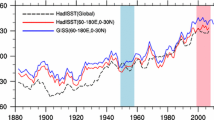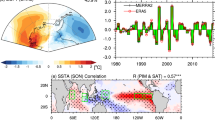Abstract
The sensitivity of the global atmospheric and oceanic response to sea surface temperature anomaly (SSTA) throughout the South China Sea (SCS) is investigated using the Fast Ocean-Atmosphere Model (FOAM). Forced by a warming SST, the experiment explicitly demonstrates that the responses of surface air temperature (SAT) and SST exhibit positive anomalous center over SCS and negative anomalous center over the Northern Pacific Ocean (NPO). The atmospheric response to the warm SST anomalies is characterized by a barotropical anomaly in middle-latitude, leading to a weak subtropical high in summer and a weak Aleutian low in winter. Accordingly, Indian monsoon and eastern Asian monsoon strengthen in summer but weaken in winter as a result of wind convergence owing to the warm SST. It is worth noting that the abnormal signals propagate poleward and eastward away in the form of Rossby Waves from the forcing region, which induces high pressure anomaly. Owing to action of the wind-driven circulation, an anomalous anti-cyclonic circulation is induced with a primary southward current in the upper ocean. An obvious cooling appears over the North Pacific, which can be explained by anomalous meridional cold advection and mixing as shown in the analysises of heat budget and other factors that affect SST.
Similar content being viewed by others
References
Bao, B., and Ren, G. Y., 2014. Climatological characteristics and long-term change of SST over the marginal seas of China. Continental Shelf Research, 77: 96–106.
Barsugli, J. J., and Sardeshmukh, P. D., 2002. Global atmospheric sensitivity to tropical SST anomalies throughout the Indo-Pacific Basin. Journal of Climate, 15 (23): 3427–3442.
Enfield, D. B., and Mayer, D. A., 1997. Tropical Atlantic sea surface temperature variability and its relation to El Niño-Southern Oscillation. Journal of Geophysical Research, 102 (C1): 929–945.
Gao, C. J., Chen, H. S., Xu, B., and Zeng, G., 2014. Possible relationships among South China Sea SSTA, soil moisture anomalies in southwest China and summer precipitation in eastern China. Journal of Tropical Meteorology, 20 (3): 228–235.
Gill, A. E., 1980. Some simple solutions for heat-induced tropical circulation. Quarterly Journal of the Royal Meteorological Society, 106: 447–462.
Hong, W., and Ren, X. J., 2013. Persistent heavy rainfall over South China during May–August: Subseasonal anomalies of circulation and sea surface temperature. Acta Meteorological Sinica, 27 (6): 769–787.
Hu, W. T., and Wu, R. G., 2015. Relationship between South China Sea precipitation variability and tropical Indo-Pacific SST anomalies in IPCC CMIP5 models during spring-tosummer transition. Advances in Atmospheric Sciences, 32 (9): 1303–1318.
Huang, A. N., Zhang, Y. C., and Huang, D. Q., 2008. Numerical study of the impacts of SSTA in the South China Sea on the South China Sea summer monsoon. Chinese Journal of Atmospheric Sciences, 32 (3): 640–652 (in Chinese with English abstract).
Jacob, R. L., 1997. Low frequency variability in a simulated atmosphere ocean system. PhD thesis. University of Wisconsin, 155pp.
Jiang, J., and Qian, Y. F., 2002. Numerical experiments of impacts of sea surface semperature in South China Sea on South China Sea Monsoon. Journal of Nanjing University, 38 (4): 556–564 (in Chinese with English abstract).
Karoly, D. J., Plumb, R. A., and Ting, M., 1989. Examples of the horizontal propagation of quasi-stationary waves. Journal of Atmospheric Sciences, 46: 2802–2811.
Lee, S., Enfield, D. B., and Wang, C., 2008. Why do some El Niños have no impact on tropical North Atlantic SST? Geophysical Research Letters, 35: L16705, DOI: 10.1029/2008GL034734.
Li, S., Hoerling, M. P., and Peng, S., 2006a. Coupled oceanatmosphere response to Indian Ocean warmth. Geophysical Research Letters, 33 (7): L07713, DOI: 10.1029/2005GL025558.
Li, S., Hoerling, M. P., Peng, S., and Weickmann, K. M., 2006b. The annular response to tropical Pacific SST forcing. Journal of Climate, 19: 1802–1819.
Liu, Z., Kutzbach, J., and Wu, L., 2000. Modeling climate shift of El Niño variability in the Holocene. Geophysical Research Letters, 27 (15): 2265–2268.
Peng, S., Robinson, W. A., and Hoerling, M. P., 1997. The modeled atmospheric response to midlatitude SST anomalies and its dependence on background circulation states. Journal of Climate, 10 (5): 971–987.
Peng, S., Robinson, W. A., Li, S., and Alexander, M. A., 2006. Effects of Ekman transport on the NAO response to a tropical Atlantic SST anomaly. Journal of Climate, 19 (19): 4803–4818.
Plumb, R. A., 1985. On the three-dimensional propagation of stationary waves. Journal of Atmospheric Sciences, 42 (3): 217–229.
Sardeshmukh, P. D., and Hoskins, B. J., 1988. The generation of global rotational flow by steady idealized tropical divergence. Journal of Atmospheric Sciences, 45 (7): 1228–1251.
Thompson, D. W. J., and Wallace, J. M., 2000. Annual modes in the extratropical circulation. Part I: Month-to-month variability. Journal of Climate, 13: 1000–1016.
Wang, C., Wang, W., and Wang, D., 2006. Interannual variability of the South China Sea associated with El Niño. Journal of Geophysical Research, 111: C03023, DOI: 10.1029/2005JC003333.
Wu, C., Show, P., and Chao, S., 1998. Seasonal and interannual variations in the velocity field of the South China Sea. Journal of Oceanography, 54 (4): 361–372.
Wu, L., and Liu, Z., 2002. Is tropical Atlantic variability driven by the North Atlantic Oscillation. Geophysical Research Letters, 29 (13): 31-1-31-4, DOI: 10.1029/2002GL014939.
Wu, L., and Liu, Z., 2005. North Atlantic decadal variability: Air-sea coupling, oceanic memory, and potential northern hemisphere resonance. Journal of Climate, 18 (2): 331–349.
Wu, L., Li, C., Yang, C., and Xie, S.-P., 2008. Global teleconnections in response to a shutdown of the Atlantic meridional overturning circulation. Journal of Climate, 21 (12): 3002–3019.
Wu, L., Liu, Z., Gallimore, R., Jacob, R., Lee, D., and Zhong, Y., 2003. Pacific decadal variability: The Tropical Pacific Mode and the North Pacific Mode. Journal of Climate, 16 (8): 1101–1120.
Wu, R., and Kirtman, B. P., 2004. Understanding the impacts of the Indian Ocean on ENSO variability in a coupled GCM. Journal of Climate, 17 (20): 4019–4031.
Xie, S.-P., Xie, Q., Wang, D., and Liu, W. T., 2003. Summer upwelling in the South China Sea and its role in regional climate variations. Journal of Geophysical Research, 108 (C8): 3261–3273.
Yan, Y. F., Qi, Y. Q., and Zhou, W., 2012. Variability of tropical cyclone occurrence date in the South China Sea and its relationship with SST warming. Dynamics of Atmospheres and Oceans, 55–56: 45–59.
Zhang, J. J., Sun, Z. B., Zhou, X. L., and Yuan, J. Q., 1991. Wintertime SSTA in the South China Sea, Eurasian wave trains and the Northern Hemisphere circulation. Journal of Nanjing Institute of Meteorology, 14 (3): 425–431 (in Chinese with English abstract).
Zhao, Y. P., and Wu, A. M., 2003. Numerical experiments for the influences of SST anomalies over the South China Sea-Eastern Tropical Indian Ocean on the South China Sea monsoon. Journal of Tropical Meteorology, 19 (1): 27–35 (in Chinese with English abstract).
Zhou, L., Tam, C. Y., and Zhou, W., 2010. Influence of South China Sea SST and the ENSO on winter Rainfall over South China. Advances in Atmospheric Sciences, 27 (4): 832–844.
Author information
Authors and Affiliations
Corresponding author
Rights and permissions
About this article
Cite this article
Zhu, X., Wu, L., Zhou, J. et al. The modeled atmospheric and oceanic response to the South China Sea SST anomaly. J. Ocean Univ. China 15, 741–750 (2016). https://doi.org/10.1007/s11802-016-3028-3
Received:
Revised:
Accepted:
Published:
Issue Date:
DOI: https://doi.org/10.1007/s11802-016-3028-3




